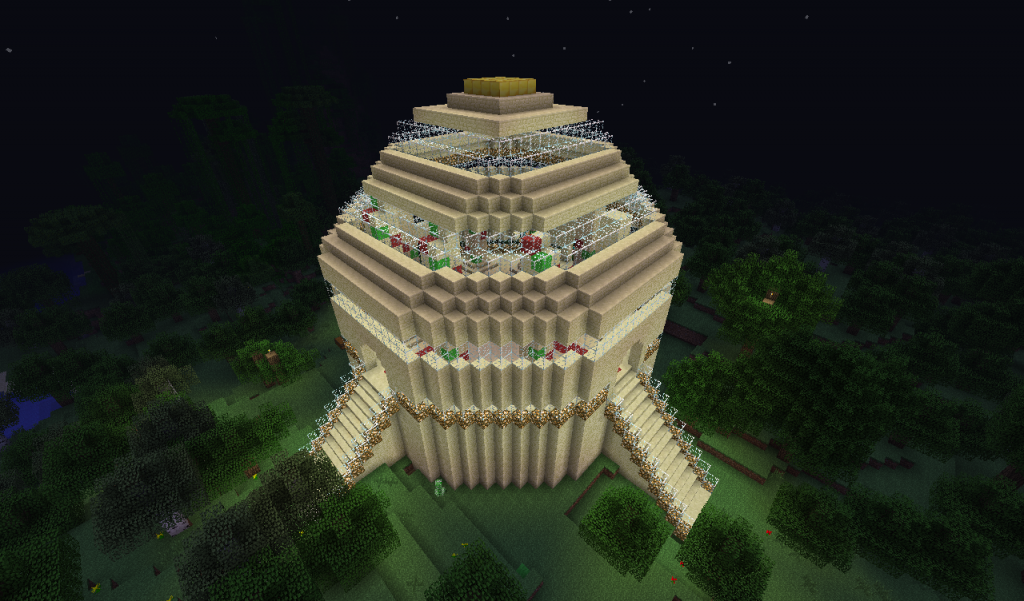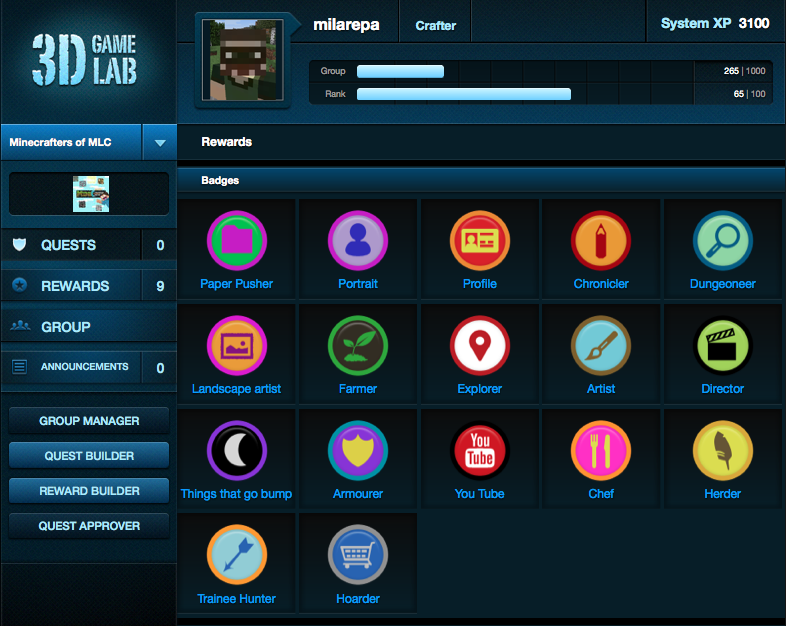“It is not enough to have a good pickaxe; the main thing is to use it well.” ~ Rene Minecartes
The quote above, posted by ChowderBowl on the Minecraft Forums, is a reminder that its not just tools that make us effective agents in the world, we need to develop skills in any particular field, be it in the social domain, academic arena or crafting Minecraft Redstone into complex circuits (or deadly traps) that is truly of greater value. We can extrapolate from this that no matter what educational technology tools your school invests in – one to one iPads, IWBs or access to applications like Prezi – its not having them that makes the learning significant but the way in which they are employed that is important. But even more than this, we need to use these skills within authentic contexts for specific purposes for specific audiences. And who better to set those than the students themselves?
In the first part of the ‘Play’s the Thing’ post you read summaries of research about the value of games and a personal recount of how we got our Minecraft server off the ground. In this post, you’ll see the firm foundation we built by constructing a student lead ‘Player Charter’ that firmly places the centre of activity (and the pickaxes) in the hands of the students.
Building the Charter
One of the attractions of Minecraft is that you can build and unbuild things. The relative anonymity that playing on a shared server means that one could be tempted to destroy other people’s constructions. From experience of interventions with students who have had their hard work damaged, it is clear that guidelines were needed – not rules per se, because anyone who has been a child knows that rules engender fleeting bouts of both fear and rebellion in sometimes equal measure – no, we needed something more than a list of commandments to which to adhere. What we needed was a Charter. Being a signatory on the Charter for Compassion gave insights into the structure and purpose behind such documents. A Charter is “…a document, issued by a sovereign or state, outlining the conditions under which a corporation, colony, city, or other corporate body is organized, and defining its rights and privileges.” (Dictionary.com) Our Minecraft server was to be, in essence, a ‘colony’ of the school. The students made it abundantly clear that our server was not something that exists outside and therefore had separate codes of conduct, yet neither was it a tool for school work alone. It was its own entity yet informed by the best aspects of our school community – respect being our only school rule. Therefore, seeing the Minecraft group as a colony served us well in defining further aspects of our Charter.
To start it all off we shared the definition of a Charter with the students and broke it down into its components. The Charter needed to –
- outline what our group believes is its purpose for existing – what we aim to do or be
- state what are our structures and roles eg – jobs and leadership positions. Who can join?
- describe our rights and responsibilities as members (this might include the sorts of acceptable and awesome behaviours)
- define what sorts of behaviours are not acceptable and what happens should they occur?
- explain how we govern ourselves and make decisions including how we change the Charter.
From this we began over several months (yes months! It took longer to make it stronger) to build our shared understanding of our purpose and core reasons for existing before we would make the server open to younger students and the wider school community. (We wrote drafts on Primary Pad and published them on our Schoology Group – an online community for our students.) We knew that if we were to lay these foundations with a shared sense of ownership, we had the potential to circumvent the difficulties we had observed on other Minecraft servers. We took the premise of Minecraft as the source and the students experience of navigating the tricky waters of interactions, ownership and compliance in external servers.
The Finished Charter
Firstly, Minecraft is a permissive space that encourages you to find things out for yourself – it does not come with a handy volume of Do’s and Don’ts to constrain behaviour. This permissiveness and openness if reflected in the details of the Charter.
Our Minecraft Community exists to
- provide its members with a space to create, collaborate and innovate.
- play and enjoy social time together
- provide opportunities for students to design personal and collaborative projects
- provide opportunities for leadership and mentoring
The group is not about leveraging Minecraft for educational outcomes UNLESS the students choose so to do. Our seniors were particularly clear that this was to be a safe space not solely an educational space. A lot of trust was gained in agreeing to this and it has been interesting to see the commitment our young leaders have shown to supporting the younger players as a result. From the outset the leaders understand that Minecraft is both social and private – it is about creating but also about engaging in discussion.
The members in our community are
- ONLY students and teachers
This was unanimously agreed to though the students were intrigued by the opportunity of engaging in shared projects with other schools at some point. We have potential links to schools in Tasmania and New Jersey but would be keen to establish further links.
I agree to
- Contribute to collaborative projects
- work together when necessary and also play alone when required
- encourage players to be the best they can be
- be respectful at all times
- participate in face-to-face meetings to make decisions
- be imaginative with solving problems
- share resources with other players
Our Charter recognises the need for opportunities to be together but also to pursue personal projects. Already, in the time we have been playing (only a handful of weeks) we have seen students design their own personal ‘houses’ whilst collaborating on farms, storehouses, resource gathering and construction of a historically accurate village based on the Victorian Gold Rush of the 1860s. Playing in Survival mode means that if there is no food, there is no hope of fulfilling your desires. More people farming means more food for all which, in turn, means more time for creating either together or alone. They are still learning that kind words while playing encourage others to come to your aid when in need.
And one thing we have learned is that players need to have facetime in order to connect with each other. These essential meetings to check in on the day begin with three questions – What’s been average? What’s been awesome? What’s on your agenda? These are the 3As that briefly allow is to meet, share and plan for what we are to achieve in that session.
I will not-
- Demolish other people’s builds (Grief) without expressed permission. I understand that if this occurs I will need to explain my actions to senior members of the group and make necessary repairs.
- Share the server address to any non-school players including family and friends outside of the school community.
- let participating interfere with my friendships, classwork or homework.
The first two points are obvious, dealing as they do wit respect and safety. This last point has been particularly important and was inserted by teachers only after discussion with parents and the students. Curiously enough, the students understood that Minecraft was a distraction from other requirements that needed to be managed carefully.
I understand
- That I may gain status and privileges if I engage positively with the activities set out within the Minecraft Community.
- That I may be removed from the Community if I am seriously in breach of the Player Charter
It is here that the conversation with the players continues. What, for them, would constitute status, rewards and privileges? They set the boundaries and the prizes too with imaginative input from teachers.
Conclusion
It’s taken nearly two years but it has been worth it as the beginning builds have shown. More than that, the way plays share and encourage others is reward enough for us as educators.
It is at this point that we enter the realm of game mechanics. The Charter sets up the purposes and community values but what we needed is some way to encourage further interdependence and collaboration. How were we to engender and support the Minecraft players, the community, to galvanise itself around student lead projects and reward them appropriately? This is where we turned to 3D Gamelab and the next blog in this series.



Recent Comments